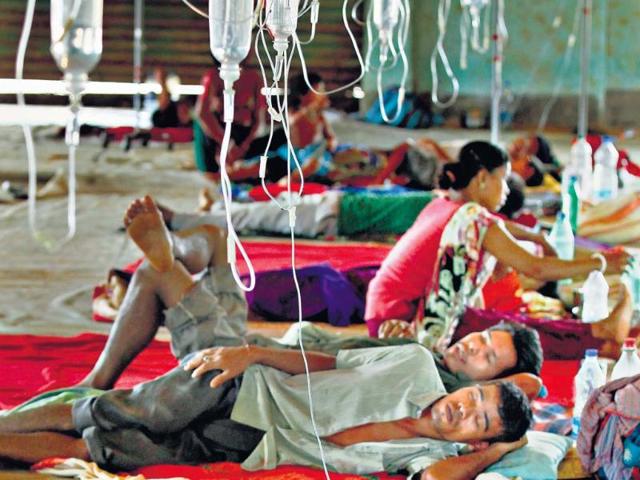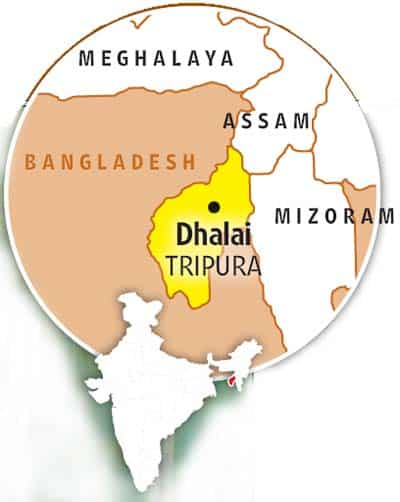The sting in the tale: How Tripura is grappling with an outbreak of malaria
A sudden outbreak of malaria has ravaged Tripura. HT travels to Dhalai, the epicentre of the problem, to find an unprepared state government coming to grips with the crisis.
Ninety-three kilometres from Agartala, the capital of landlocked Tripura, is the Dhalai District Hospital. From the outside, the cream-coloured building looks impressive: it has three floors, a spacious vehicle parking zone, a waiting area for patients and their families, and a large lobby. Inside, it’s a different story; it is as ramshackle as the state’s healthcare system. Its cover was blown this June when the state found itself in the grip of an unprecedented malaria outbreak in five of its eight districts. Dhalai, one of India’s 250 most backward districts, is the epicentre of the crisis. The first cases (eight deaths of which six were children) were reported from the Gandachara subdivision of the district on June 10.

On the first floor of the hospital are two large halls, the makeshift “malaria wards”. They have no beds, only haphazardly kept brown Rexene-covered mattresses on the floor for patients and their families; clothes, bags, utensils and IV stands with medicine pouches were scattered all over the place. Despite the 70-odd patients — several of them sick children in tattered clothes lying motionless — the wards were eerily quiet.
According to the state’s Left Front government, more than 1,01,025 people, mainly tribals, have fallen ill with malaria and fever. 69 have died and more than 31,374 have been infected. Ninety percent of the dead are children below the age of 10 years. This is because tribal children are malnourished and have low immunity. In 2013, there were 2,561 malaria cases and only one death.
The unofficial figure is said to be much higher. Accusing the government of failure, Congress MLA Ratan Lal Nath told Tehelka recently: “The actual toll could be double as many deaths from far-flung areas are never reported. The tribals depend on quacks as they have never seen the face of any medical service in their village”. The party has demanded a judicial inquiry into this ongoing public health emergency. On July 17, the state Congress filed an FIR against three senior health officials accusing them of negligence and buying the wrong malaria drugs for two years, which the state government has denied.
“Though the state is a malaria endemic zone, it never had such a health crisis. Several village elders told me that they have never seen so many people dying due to malaria,” Dhalai district collector (DC) Dr Milind Ramteke said. For Ramteke, a physician who has served in Gadchiroli in Maharashtra, it was a baptism by fire. He took over as DC on May 26 and the crisis erupted on June 10. “I have told the field staff not to hide the number of deaths,” he told HT when asked about the correct toll.

As news trickled out about the malaria deaths, a few weeks ahead of the panchayat elections (July 15), the government took a series of decisions: it suspended 50 rural health workers (the lowest tier), reprimanded doctors and cancelled their leaves, and organised health camps. Until July 13, it had organised 4,078 health camps and large-scale sensitisation programmes, and flooded the public health centres (PHCs) with second-generation medicines (the state was declared malaria-drug resistant in 2009) and rapid diagnostic kits (RDK). It sent out DDT (used for vector control) spray teams even to the “inaccessible” mountainous areas, home to Primitive Tribal Groups (PGT) like the Reangs, the Tripuri and the Molsom.
According to WHO, there are no licensed vaccines against malaria. Globally, the death toll for malaria is falling. The same is the case in other parts of India. This sudden resurgence of the vector-borne disease could have been averted only if the state had taken several proactive steps between March and June, the mosquito breeding season.
One of the main reasons for the crisis is the criminal delay in DDT spraying. “In April, we submitted a plan for DDT spraying but in May, we received a memo that only 12 sub centres had been selected for spraying because the 2013 annual parasite incidence report was low. Last year, DDT spraying started on May 20. This year, it was May 30,” said Ajit Sharma, consultant, District Vector Borne Disease Control Programme, Dhalai. Dr Ramteke supported this claim: “No funds were approved for DDT and no preventive measures were taken between March and May”. DDT spraying takes time: A six-member team can reach out to only 30-35 households per day.
Tribals, whom this reporter met at many health camps, revealed that DDT had not been sprayed in their villages for years and that heath workers never visit. “The last mosquito net I got from the government was in 2011,” said Thana Rai Reang, a farmer, from Dhonorampara village.
That there has been a complete collapse of the health structure in the districts is also accepted by the government. “Many ASHA (Accredited Social Health Activist) workers, anganwadi workers and multi-purpose workers (MPW), who are supposed to sensitise people on how to avert malaria, were not available in the villages,” health minister Badal Choudhury told a press meet. “They exist mainly on paper,” Dr Ramteke said. However, many in the districts alleged that such ghost workers are affiliated to the ruling party and are busy with party-related work. In the 2013 assembly elections, the Manik Sarkar government won all 20 seats reserved for tribals in the 60-member house.
“My four-year-old son had high fever for four days but there was no one I could report it to,” said Selam Kumar Debbarma, 45. For the last 10 days he has been camping at a heath camp that has been started in a CRPF godown.
In the absence of heath workers, doctors at sub centres of Public Health Centres (PHC) and road connectivity to PHCs, many tribals are forced to rely on traditional healers. “They trust them more than our doctors. Tribals only come to PHCs when the fever continues for 10 to 15 days,” said a health official. Tribal communities are very poor and sometimes have to spend Rs 100-Rs 200 on medicines at private chemist shops because of inadequate stock at the health centres. On the other hand, traditional healers can be paid in kind and that too after a few months. This lack of presence of ground level medical staff led to a communication breakdown between the lowest administrative tier and the highest one, the district administration.
ASHA workers refuse to shoulder the blame: they accuse the government of not paying their dues (they don’t get salaries but incentive-based payments) on time, and of delays in providing RDKs and ORS (Oral Rehydration Salts) packets. “We get only Rs 15 per patient for malaria testing and Rs 75 if the test is positive,” said Nayantra Debbarma, an ASHA worker. “We have to take the slides to PHCs and then go for the report. We spend a lot on transport”.
However, there was no shortage of funds. Despite a central warning to re-energise its vector-borne disease projects, the state utilised just 21% of the total funds in 2012-13. In 2013-14, the state was allocated Rs 193 crore under NRHM (National Rural Health Mission), of which only Rs 17.80 crore was given to vector-borne disease, leading to a shortage of medicines and insecticide-treated mosquito nets. On June 3, additional director of the National Vector Borne Disease Control Programme Dr Avadesh Kumar said in Agartala that while all north-eastern states had performed well in tackling vector-borne diseases Tripura had performed miserably.
Several government officials and doctors claim that a lack of infrastructure and the tribals themselves are to be blamed for such outbreaks. “There are still many inaccessible villages. Doctors don’t want to stay in sub centres in those areas because of a lack of drinking water and sanitation,” said Dr Arun Das, who is in charge of a PHC sub centre. “Health care professionals cannot function in a vacuum like this”.
Since many tribals don’t finish the full course of medicines, they become drug resistant. “These people then become moving reservoirs and once a mosquito bites them, it can infect others. There are many malaria cases even in winter because of this,” Dr Das added. Moreover, since May-June is peak season for jhum cultivation — the tribals’ sole source of income — most are away toiling in fields that swarm with mosquitoes.
The government’s failure to devise a communication programme, that explains why some behaviour patterns need to change, is also to blame. Since they don’t wear clothes that fully cover their bodies, tribal people are susceptible to mosquito bites. They are reluctant to give blood for testing; they don’t allow DDT spraying inside their homes, which have poor sanitation, and rear pigs close to their homes. For it’s part, the government has put up flex banners that enumerate behavioural dos and don’ts that could prevent malaria. However, they are all in Bengali, a language the tribals don’t read.
The state’s health structure also has bypassed the village headman in spreading the anti-malaria information, though these individuals have an enormous hold on villagers. “We need to reach out to them in their own language,” said Dr Padma Jamatia, Dhalai district malaria officer, accepting that the government needs to revise its communication plan. “You cannot end malaria. The vectors are more powerful than us. We are now working on a comprehensive plan to avoid such an outbreak again,” Dr Ramteke promised. (See box). Hopefully, the government will learn from the stinging lesson that it has got this year.
Voices: The road ahead

‘Medicine stock low’
Badal Choudhury
Health minister, Tripura
There was no such outbreak for years, so we did not take any precautionary measures. The anti-malarial medicine stock was low. When the outbreak happened, we could not reach out to the patients immediately as the rains had washed out the roads. We have started more than 3,000 health camps since. We will use our strong panchayat setup to reach people.

'Must work together'
Pradyot Deb Barman
State Congress general secretary
Social and hygiene issues may have been behind this outbreak, but the government was slow to react as well. We, as the opposition, should also take responsibility of concentrating too much on the urban areas. We must now try to contain this outbreak by working with all organisations regardless of their political affiliations.

‘Reach the people’
Chandrakanto Malsom
World Vision India (NGO) official
Different components need to be looked into — environment, government health systems and social practices of the tribal people — for effectively mapping the intensity of the malaria issue. Reaching people living in remote places should be a focus. We can’t wait for them to come to health centres; we should reach them first.

‘Use local languages’
Dr Milind Rameteke
District Collector, Dhalai
We need anti-malaria awareness campaigns in local languages. We will distribute 15,000 insecticide-treated bed nets and intensify MNREGA work so that tribals have money to spend on health. Village Health and Nutrition Day campaigns should include several departments as well as village headmen.
Get Current Updates on India News, Lok Sabha election 2024 live, Election 2024 along with Latest News and Top Headlines from India and around the world.




